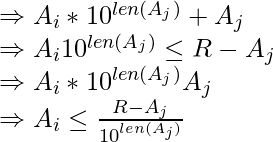Given an array arr[] of size N and integers L and R defining the given range, the task is to find the number of elements in the given range that can be generated by concatenating any two elements of the array.
Examples:
Input: N = 2, L = 10, R = 52, arr = {2, 5}
Output: 3
Explanation: All pairs available
(2, 2) => 22 (10 ≤ 22 ≤ 52)
(2, 5) => 25 (10 ≤ 25 ≤ 52)
(5, 2) => 52 (10 ≤ 52 ≤ 52)
(5, 5) => 55 (10 ≤ 55 > 52) invalid
Hence output is 3.Input: N = 3, L = 100, R = 1000, arr = {28, 5, 100}
Output: 2
Explanation: The only valid pairs available
(28, 5) => 285 (100 ≤ 285 ≤ 1000)
(5, 28) => 528 (100 ≤ 528 ≤ 1000)
Rest other pairs either fall short or higher then given range
Hence output is 2.
Approach: The idea to solve the problem is based on the following observation:
Observations:
- The length of the valid pair is crucial as it can help us to distinguish right pairs.
- If length is permissible we need to check whether every element is in the boundary or not.
- Similarily

Follow the below steps to implement the above approach:
- First sort the given array.
- Find the length of the first element of the pair
- For any pair {x, y}, x * 10len(y) + y gives the value of “xy” when they are concatenated.
- Then, simply iterate j from 1 to N:
- Use the above condition to find the range where the other value (say x) will lie.
- Use binary search to find how many possible array elements are there in the range which can assume the value x.
- Increment the count by that much.
- The final count is the required answer.
Below is the implementation for the above approach:
C++
|
|
Time Complexity: O(N * logN)
Auxiliary Space: O(1)


.png)
